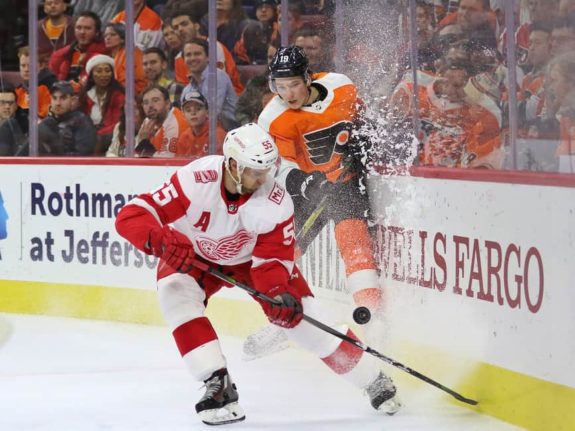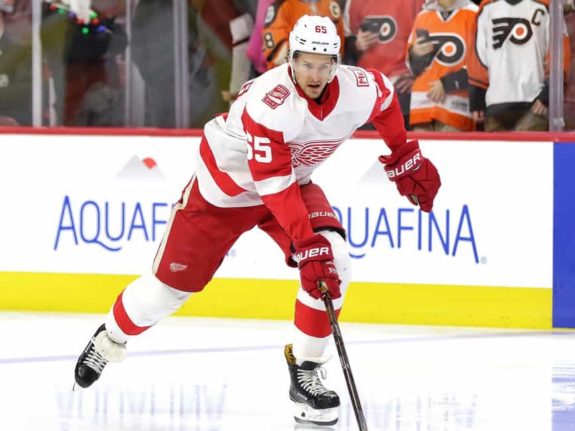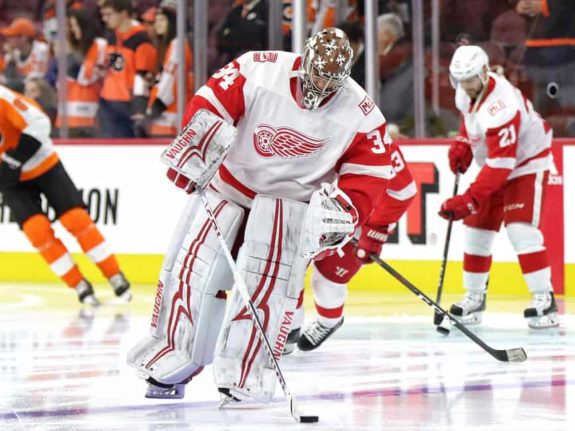For the Detroit Red Wings, the 2018 NHL trade deadline represents yet another opportunity to build on their rebuild. Like last year, general manager Ken Holland will attempt to sell off veterans and rentals for prospects and picks.
For fans, the deadline also represents a chance to deal players who have fallen out of favor. The common theme among the many trade suggestions is that these Red Wings are taking up valuable ice time that could be doled out to prospects who might be impact players down the road.
However, some players just cannot be traded. For varying reasons, these Red Wings will likely remain in Hockeytown for the foreseeable future and will not be sacrificed for the rebuild.
Here’s why.
Player Value – Internal and External
One of the many players referenced in the “trade him!” comments is Niklas Kronwall. The long-time Red Wing has been hobbled by chronic knee problems over the past few years and just isn’t the hard-hitting force he once was. (And no, Kronwall can’t go on long-term injured reserve when he’s played in 45 of the 48 pre-All-Star-break games this season.)
Injury concerns aside, there’s no chance that Detroit trades him. Kronwall is worth too much to the team than the expected return in a trade (likely a fifth or sixth-round pick).

The Athletic’s Eric Duhatschek recently penned an article regarding Jaromir Jagr’s impact on the Flames, which can also shed some light on Kronwall’s value to the Red Wings. Calgary’s Curtis Lazar told Duhatschek:
The mentorship role, he talks about his glory days back with Pittsburgh and what he did and how to prepare. Even with me, he talked to me about playing limited minutes and trying to stay ready and what I have to do to be prepared. He knows how tough it is. Everything that he says, you just act like a sponge and soak it all up.
(from ‘Duhatschek: Jaromir Jagr’s short-lived mentorship role with Flames will have lasting impact’, The Athletic NHL – 1/30/18)
Today, while still competing to the best of his ability, Kronwall plays this role for the Red Wings’ young players.
He was there for the 2008 Stanley Cup with Henrik Zetterberg, Pavel Datsyuk, and Nicklas Lidstrom leading the charge. Kronwall’s Red Wings tenure also overlapped with Steve Yzerman, Brendan Shanahan, Chris Chelios, Kris Draper, and Brett Hull. If you need advice about how to be prepared to win night in and night out, these are the guys to turn to. Now, Kronwall is passing down that wisdom to Detroit’s next generation.
Though “veteran leadership” and “locker-room presence” are terms that are tossed around a lot, they do have value. Kronwall’s true value really can’t be quantified though, since it combines both qualitative (leadership) and quantitative (on-ice statistics) factors. So when evaluating Kronwall, Zetterberg, and—to lesser extents—Justin Abdelkader and Jonathan Ericsson, consider their presence as a value-add for the rest of the team. But for the latter two (and others), a separate element also comes into play when reviewing their trade value: their contracts.
Trading Bad Contracts
Consider this scenario: Player X with an appropriate salary and term for his talent level has a trade value of a second-round pick or an established B-level prospect. Now, let’s replace that solid contract with a long-term deal that pays a little more than that player is probably worth. His trade value would then drop, likely to a mid-round selection.
Teams wouldn’t pay as much to acquire that player because they could probably find a comparable player elsewhere with a more team-friendly contract. Term and salary can be burdensome when trading for a player, especially if the acquiring team is already strapped for cap space.
With the above scenario in mind, why would you trade a player for less than they’re worth unless you’re desperate for cap space?

Back to the Red Wings. Several players fit this description, including Abdelkader, Ericsson, Danny DeKeyser, Darren Helm, and Frans Nielsen. Either their contract term or cap hit (or both) reduces their trade value since any acquiring team—save a few penny-pinchers—would need to clear cap space of their own before trading for them. And the Red Wings certainly don’t intend to retain salary on a traded long-term contract.
If Detroit really needed to clear cap space, some of these players could be moved, but for far less than what they’re worth to the Red Wings.
Performance Issues
The last trade value factor to consider is the player’s recent performance. For Detroit, they have quite a few players who have regressed over the past few years, with Petr Mrazek as the most notable (though he’s shown signs of life in January). Xavier Ouellet could also be classified in this manner.

If someone isn’t playing well, there won’t be as much demand for him as there would be if the player was on a hot streak. A lack of demand means a lower return for the Red Wings if they were to trade that player.
Think about it: Mrazek is probably worth a third-round pick (or less) at this point. But what if the Red Wings traded him during the 2015-16 season when he grabbed a hold of Detroit’s starting job? His value was much higher then and probably could have netted a first-round pick if dealt.
Related – The Grind Line: Other Red Wings on the Trading Block?
Final Word
When seeking out a trade for a player who has fallen out of favor, consider the three factors above—plus others, like age and no-movement clauses—and the fact that the Red Wings have more than a few players who fit into two or more of the categories. As such, it’s highly unlikely that Abdelkader, DeKeyser, Ericsson, Helm, Kronwall, Nielsen, or Zetterberg will be dealt in the near future.
Part of executing a rebuild is picking your spots. Simply purging the whole roster isn’t the solution, especially when you already have pieces in place to carry your team forward. It’s up to Holland to maximize trade value and sell when the time’s right or hold onto players who have additional value.